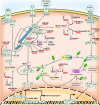The Crosstalk Between Regulatory Non-Coding RNAs and Nuclear Factor Kappa B in Hepatocellular Carcinoma
- PMID: 34804980
- PMCID: PMC8602059
- DOI: 10.3389/fonc.2021.775250
The Crosstalk Between Regulatory Non-Coding RNAs and Nuclear Factor Kappa B in Hepatocellular Carcinoma
Abstract
Hepatocellular carcinoma (HCC) is a highly lethal type of malignancies that possesses great loss of life safety to human beings worldwide. However, few effective means of curing HCC exist and its specific molecular basis is still far from being fully elucidated. Activation of nuclear factor kappa B (NF-κB), which is often observed in HCC, is considered to play a significant part in hepatocarcinogenesis and development. The emergence of regulatory non-coding RNAs (ncRNAs), particularly microRNAs (miRNAs) and long non-coding RNAs (lncRNAs), is a defining advance in cancer biology, and related research in this branch has yielded many diagnostic and therapeutic opportunities. Recent studies have suggested that regulatory ncRNAs act as inhibitors or activators in the initiation and progression of HCC by targeting components of NF-κB signaling or regulating NF-κB activity. In this review, we attach importance to the role and function of regulatory ncRNAs in NF-κB signaling of HCC and NF-κB-associated chemoresistance in HCC, then propose future research directions and challenges of regulatory ncRNAs mediated-regulation of NF-κB pathway in HCC.
Keywords: chemoresistance; hepatocellular carcinoma; long non-coding RNA; microRNA; nuclear factor kappa B.
Copyright © 2021 Zhang, Shao, Li, Liu and Zheng.
Conflict of interest statement
The authors declare that the research was conducted in the absence of any commercial or financial relationships that could be construed as a potential conflict of interest.
Figures

Similar articles
-
Non-coding RNAs in hepatitis C-induced hepatocellular carcinoma: dysregulation and implications for early detection, diagnosis and therapy.World J Gastroenterol. 2013 Nov 28;19(44):7836-45. doi: 10.3748/wjg.v19.i44.7836. World J Gastroenterol. 2013. PMID: 24307777 Free PMC article. Review.
-
Non-coding RNAs targeting NF-κB pathways in aquatic animals: A review.Front Immunol. 2023 Feb 6;14:1091607. doi: 10.3389/fimmu.2023.1091607. eCollection 2023. Front Immunol. 2023. PMID: 36825023 Free PMC article. Review.
-
The Underlying Mechanisms of Noncoding RNAs in the Chemoresistance of Hepatocellular Carcinoma.Mol Ther Nucleic Acids. 2020 Sep 4;21:13-27. doi: 10.1016/j.omtn.2020.05.011. Epub 2020 May 15. Mol Ther Nucleic Acids. 2020. PMID: 32505000 Free PMC article. Review.
-
A hMTR4-PDIA3P1-miR-125/124-TRAF6 Regulatory Axis and Its Function in NF kappa B Signaling and Chemoresistance.Hepatology. 2020 May;71(5):1660-1677. doi: 10.1002/hep.30931. Epub 2019 Oct 23. Hepatology. 2020. PMID: 31509261 Free PMC article.
-
MicroRNA-127-5p targets the biliverdin reductase B/nuclear factor-κB pathway to suppress cell growth in hepatocellular carcinoma cells.Cancer Sci. 2016 Mar;107(3):258-66. doi: 10.1111/cas.12869. Epub 2016 Feb 9. Cancer Sci. 2016. PMID: 26708147 Free PMC article.
Cited by
-
lncRNA-microRNA axis in cancer drug resistance: particular focus on signaling pathways.Med Oncol. 2024 Jan 9;41(2):52. doi: 10.1007/s12032-023-02263-8. Med Oncol. 2024. PMID: 38195957 Review.
-
LincRNA-miR interactions in hepatocellular carcinoma: comprehensive review and in silico analysis: a step toward ncRNA precision.Naunyn Schmiedebergs Arch Pharmacol. 2025 May 23. doi: 10.1007/s00210-025-04285-7. Online ahead of print. Naunyn Schmiedebergs Arch Pharmacol. 2025. PMID: 40410550 Review.
References
Publication types
LinkOut - more resources
Full Text Sources

